 |
|
|
With Rutherford Hayes declining to run for
a second term, the Republications chose James
A. Garfield as their candidate at the convention
in 1880. Garfield had a long career in the House
of Representatives.
Early Life
James was born in Cuyahoga County, Ohio,
in 1831. Fatherless at two, he was said to be
a dreamer, with his head stuck in novels and
lost in fantasy. He left home at sixteen and
drove canal boat teams, where he fell overboard
fourteen times in six weeks and ended up in
bed seriously ill. His mother persuaded him
that education was valuable, and she scraped
together seventeen dollars to send him to an
academy, where he discovered a lifelong love
of learning. He was graduated from Williams
College in Massachusetts in 1856, and he returned
to the Western Reserve Eclectic Institute (later
Hiram College) in Ohio as a classics professor.
Within a year he was made its president. Garfield
was elected to the Ohio Senate in 1859 as a
Republican. During the secession |
|
| crisis, he
advocated coercing the seceding states back
into the Union, but he did put aside his belief
in pacifism to fight. In 1862, when Union military
victories had been few, he successfully led
a brigade at Middle Creek, Kentucky, against
Confederate troops. At 31, Garfield became a
brigadier general, and two years later he was
a major general of volunteers. Meanwhile, in
1862, Ohioans elected him to Congress. President
Lincoln persuaded him to resign his commission:
It was easier to find major generals than to
obtain effective Republicans for Congress. Garfield
repeatedly won reelection for 18 years, and
became the leading Republican in the House.
A staunch abolitionist before the Civil War,
Garfield became a Radical Republican after Lincoln's
assassination. |
The Election of 1880
In the election of 1880, the Republican
ticket looked like it would boil down to a fight
between former president Ulysses S. Grant and
the more moderate James G. Blaine. Garfield
surprised everyone, however, by earning more
and more votes in the convention balloting.
He won the presidential nomination, and eventually
the election, against Democrat Winfield S. Hancock,
a Civil War hero. The election was the closest
on record. Garfield won by the narrowest of
margins, and only with the help of the New York
political boss Senator Roscoe Conkling, with
whom Garfield had agreed to consult on party
appointments (Conkling had been a prominent
figure in the civil service reform issue because
of his control over appointments to the Port
of New York). Had New York or Indiana gone Democratic,
Garfield would have lost the presidency.
The Garfields
Both James and Lucretia Garfield were devout
members of the Disciple of Christ church. "Crete"
devoted |
|
|
|
herself to raising the Garfield's five
children, all of whom grew up to have rather
distinguished careers. Though she dreamed of
refurbishing the executive mansion, Mrs. Garfield
caught malaria from the swamps behind the White
House before she could begin
the project. Eventually, she enjoyed a complete
recovery and lived to the ripe old age of eighty-six.
Issue: The Economy
Garfield earned a reputation as an expert
on economics while serving in the House. He generally
agreed with the economic reform policies of his
predecessor, although he advocated a return to
the gold standard. Garfield saw the economy as
a moral issue. |
|
Issue: Civil Service Reform
Garfield believed in the idea of civil service
reform in theory, but he had doubts about the
use of merit examinations as a sole criteria for
advancement. Garfield seemed to recognize that
the spoils system supplied necessary money and
workers to the political parties. Only three weeks
into his administration, Garfield allowed Secretary
of State James Blaine to persuade him to nominate
a non-Conklingite as collector of the Port of New
York. Senator Conkling was outraged and he urged
his fellow senators to reject the appointment.
Conkling was losing the fight when he came up
with the idea of resigning from the Senate. His
strategy was that the political machine he controlled
in New York would send him right back with overwhelming
support, and he hoped this show of force would
move other senators to support him. This strategy
backfired, however, as Conkling's followers
deserted him and he was forced into private
life. |
Assassination
President Garfield never had a chance to
press this political advantage. On July 2, 1881,
only four months into his term, Garfield was
shot in the back by Charles Julius Guiteau,
an emotionally disturbed man who had failed
to gain an appointment in Garfield's administration.
Garfield lived for two agonizing months while
doctors failed to find the bullet. Eventually,
he succumbed to blood poisoning. Had Garfield
served his term, historians speculate that he
would have been determined to move toward civil
service reform and carry on in the clean government
tradition of President Hayes. He was also determined
to fight for the civil rights of black Southerners,
as he made clear in his 1881
inaugural address. Unfortunately, he is
best remembered for his assassination. And because
his killer was a frustrated office-seeker, Garfield's
greatest legacy was the impact of his death
on moving the nation to reform government patronage.
Supporters of civil service reform used the
assassination to get some real legislation passed,
the 1883 Pendleton Civil Service Reform Act. |
|
|
|
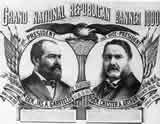
1880 Grand National Republican Banner
|

1881 Engraving of Garfield's Assassination |
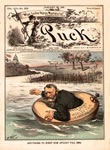
"Anything To Keep Him Afloat Till 1884," Puck, January 26, 1881, by Frederick Opper |
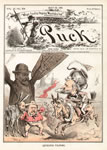
"Quixotic Tilting," Puck, May 18, 1881, by Carl Elder von Stur |
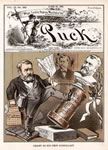
"Grant as His Own Iconoclast," Puck, June 15, 1881, by Carl Elder von Stur |
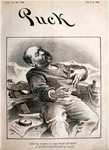
"Struck Down at the Post of Duty," Puck, July 6, 1881 |
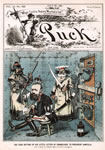
"The Czar Getting Up His Little Letter of Condolence to President Garfield," Puck, July 27, 1881, by Frederick Opper |
|
|
|
|
| |
|

|
|
|
|
|
|
|
|
|
|

